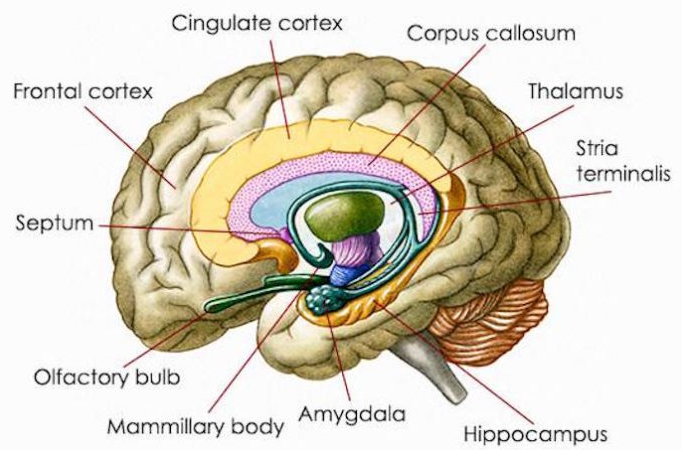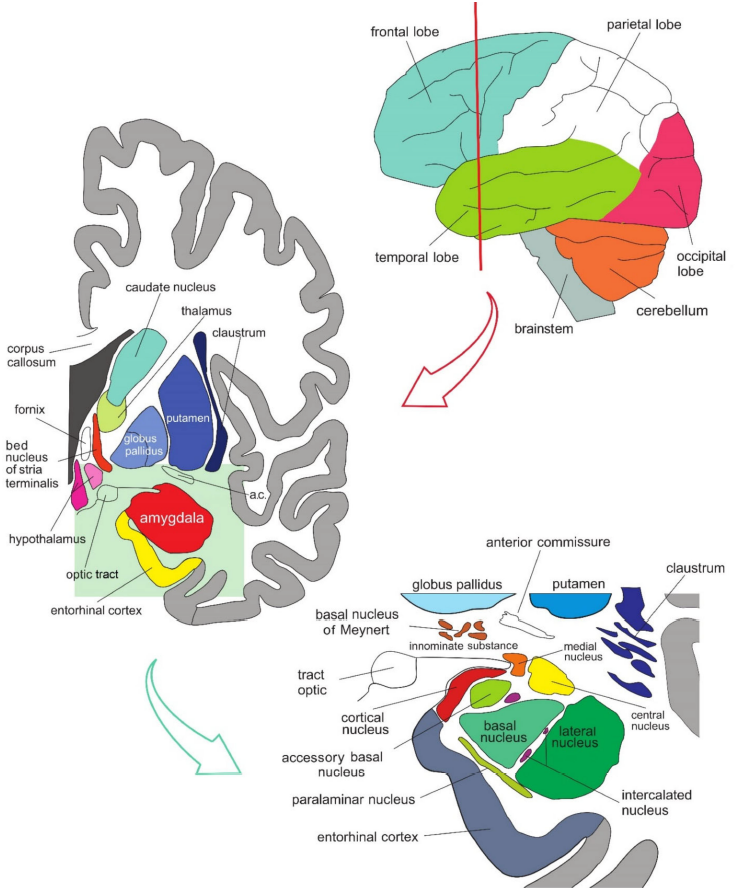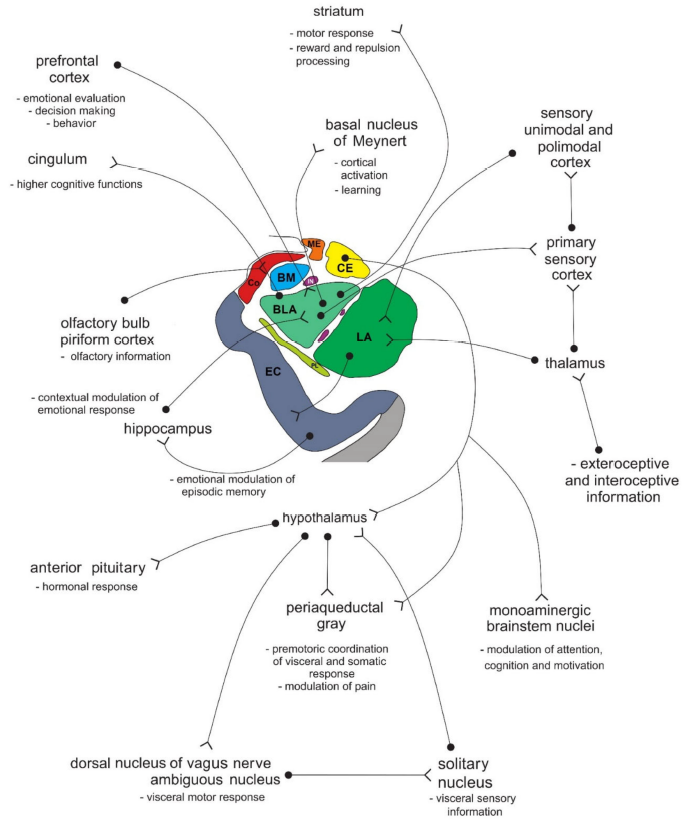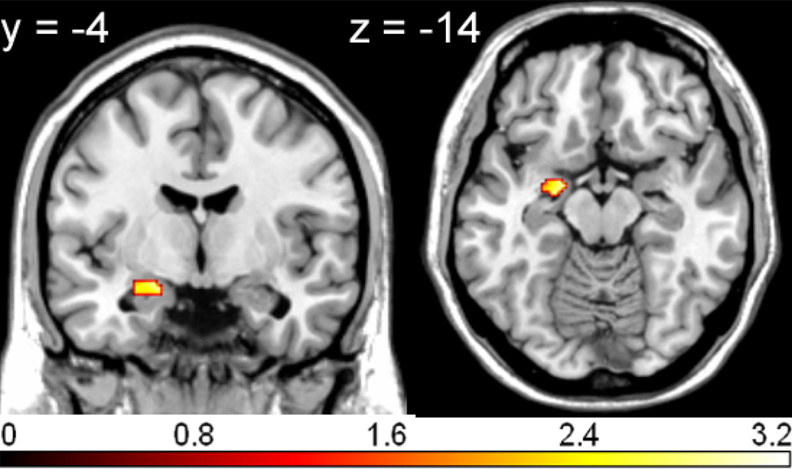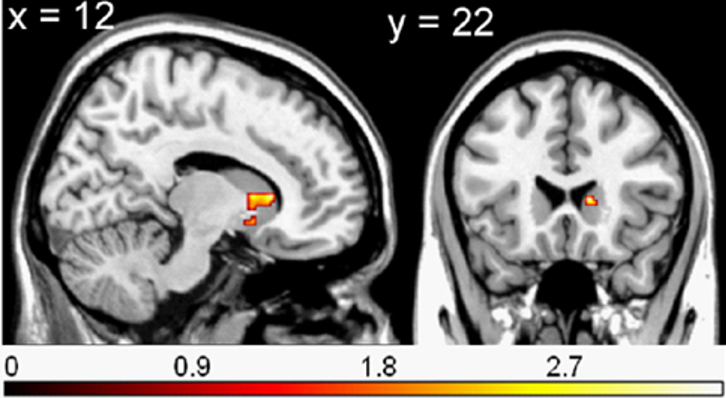|
|
||
|
The amygdala, a small almond-shaped structure nestled deep within the human brain, serves as a fascinating and complex hub for our emotional experiences and survival instincts. Often referred to as the brain's "emotional center," this intricate network of nuclei is responsible for processing and responding to a wide range of stimuli, from the subtle cues of social interaction to the primal triggers of fear, anxiety, and aggression. While its primary function is to ensure our survival by rapidly initiating the fight-or-flight response in the face of danger, the amygdala's influence extends far beyond this instinctive reaction. It plays a crucial role in learning, memory consolidation, and the formation of emotional associations, shaping our perceptions of the world and the people around us. Understanding the amygdala's intricate workings is not only essential for unraveling the mysteries of human emotions but also for developing effective treatments for a variety of mental health disorders. In this in-depth exploration, we delve into the multifaceted role of the amygdala, examining its anatomical structure, neural connections, and the diverse functions it performs in both typical and atypical brain functioning.
Where is it ?The amygdala is located deep within the temporal lobe of the brain, situated just in front of (anterior to) the hippocampus. It is a paired structure, with one amygdala residing in each hemisphere of the brain. The amygdala is part of the limbic system, a complex network of interconnected structures. In the illustration shown below, Amygdala is highlighted in green and is located deep within the temporal lobe of the brain. It sits just anterior to the hippocampus and medial to the temporal lobe's more lateral structures. The image illustrates the amygdala's position relative to other key brain structures like the hippocampus, thalamus, and frontal cortex, emphasizing its central role in the limbic system. Image Source : Protecting Your Brain From The Damaging Effects of Modern Stress and Anxiety How the internal structure look like ?This intricate structure of Amygdala is composed of several nuclei, each with distinct roles in behavioral and emotional regulation. These nuclei include the lateral, basal, and central nuclei, among others, which together facilitate the amygdala's ability to modulate emotional responses based on sensory input. The amygdala's connections with various brain regions, including the prefrontal cortex, hippocampus, and brainstem, enable it to influence a wide range of physiological and psychological functions - from memory consolidation and decision-making to autonomic responses like the fight-or-flight reaction. Understanding the amygdala's structure and function is crucial for insights into human behavior and the underlying mechanisms of various psychiatric disorders. Image Source : Understanding Emotions: Origins and Roles of the Amygdala Here are the key nuclei within the amygdala based on standard neuroscientific knowledge:
How is it connected to other parts of the brain ?The amygdala serves as a critical hub in the neural architecture mainly in terms of emotion. Its intricate network of nuclei, including the Basal, Lateral, and Central nuclei, is deeply interconnected with various brain regions, orchestrating a complex dance of inbound and outbound signals. These connections facilitate the amygdala's ability to integrate sensory information with emotional significance from the sensory cortex, thalamus, and olfactory systems, while also influencing cognitive processes and behavioral outputs through pathways to the prefrontal cortex, striatum, and brainstem. The amygdala's role extends to modulating visceral functions via connections to the hypothalamus and brainstem nuclei, underlining its integral involvement in both emotional reactivity and regulation. This comprehensive interconnectivity not only highlights the amygdala's central role in emotional and behavioral responses but also its contribution to memory and decision-making processes, painting a picture of a brain structure that is as complex as it is critical. Image Source : Understanding Emotions: Origins and Roles of the Amygdala Outbound Paths (from amygdala nuclei to other brain parts)
Inbound Paths (to amygdala nuclei from other brain parts)
Unlocking the Amygdala: fMRI Sheds Light on Emotional ProcessingThe amygdala, an almond-shaped structure deep within the brain, plays a crucial role in processing emotions, particularly fear and pleasure. A study published in Frontiers in Human Neuroscience used functional magnetic resonance imaging (fMRI) to examine how the amygdala responds to different emotional stimuli. The study revealed that the amygdala was highly active when participants viewed unpleasant or fear-inducing images (as shown below), confirming its role in processing negative emotions. Interestingly, the study also found that other brain regions, such as the hippocampus and medial occipital lobe, were involved in processing unpleasant stimuli. This suggests that a network of brain regions works together to create our emotional experience.
Image Source : Brain activations to emotional pictures are differentially associated with valence and arousal ratings In contrast, pleasant images triggered activity in the left occipital regions and parts of the medial temporal lobe, areas associated with visual processing and memory. This finding indicates that the processing of positive emotions may involve different brain pathways than those responsible for negative emotions.
Image Source : Brain activations to emotional pictures are differentially associated with valence and arousal ratings This research provides valuable insights into the complex workings of the amygdala and its role within the broader context of emotional processing. While the amygdala is strongly associated with fear and negative emotions, this study highlights the diverse network of brain regions involved in generating emotional experiences. While the amygdala is crucial for processing emotions, it's not the only brain region involved. Different emotions involve different networks of brain regions. Pleasant emotions like joy and happiness seem to rely more on reward circuitry, including areas like the nucleus accumbens and ventral tegmental area, which are associated with dopamine release and feelings of pleasure. The Woman Without an Amygdala: Understanding Fear Through Patient S.MDeep within the human brain lies the amygdala, a small, almond-shaped structure that plays an outsized role in our emotional lives. This tiny cluster of neurons is the seat of fear, our brain's alarm system, triggering a cascade of responses that prepare us to confront or flee from danger. But what happens when this critical structure is absent? The extraordinary case of Patient S.M. provides a unique window into the amygdala's function and its profound impact on human experience. S.M., a woman living without a functioning amygdala, offers invaluable insights into the neuroscience of fear and the intricate workings of the brain. S.M. is a women who lives with a condition that many might consider a superpower: she cannot experience fear. This isn't due to bravery or learned behavior, but rather a rare genetic disorder called Urbach-Wiethe disease. This disease gradually calcifies and destroys the amygdala, a small almond-shaped structure deep within the brain. The Amygdala: The Brain's Fear HubThe amygdala plays a crucial role in processing emotions, especially fear. Think of it as the brain's alarm system. When we encounter a threat, the amygdala triggers a rapid "fight-or-flight" response, preparing us to confront danger or escape. It's responsible for the pounding heart, sweaty palms, and heightened senses we experience when afraid. In S.M.'s case, Urbach-Wiethe disease has caused complete bilateral damage to her amygdala. This absence of a functioning amygdala has rendered her essentially fearless. A Life Without Fear: The S.M. Case StudyNeuroscientists have been studying S.M. for years, intrigued by her unique condition. They've exposed her to a range of fear-inducing stimuli: handling snakes and spiders, navigating a haunted house, even watching horror films. Despite these efforts, S.M. reports no feeling of fear, and her physiological responses remain unchanged. Followings are some of the episodes about S.M. These episodes offer a glimpse into S.M.'s unique experience of the world, a world devoid of the fear that shapes so much of human behavior. While her condition might seem enviable at first glance, it highlights the complex and essential role that fear plays in our lives.
This lack of fear, while seemingly advantageous, presents its own set of challenges. Fear serves an important evolutionary purpose: it helps us avoid danger. Without it, S.M. has faced numerous risky situations throughout her life, highlighting the crucial role fear plays in survival. For instance:
These examples illustrate how S.M.'s lack of fear, while seemingly a superpower, can actually make her more vulnerable. Fear is a vital emotion that helps us navigate a complex and often dangerous world. It allows us to assess threats, avoid risky situations, and protect ourselves. S.M.'s case serves as a powerful reminder of the crucial role that fear plays in our survival and well-being. Unlocking the Secrets of the BrainS.M.'s case has provided scientists with a rare opportunity to study the amygdala's function in isolation. Her experiences have deepened our understanding of how the brain processes fear, how fear interacts with other emotions, and the potential consequences of a life without it. For example:
Through the lens of S.M.'s unique condition, scientists have gained valuable insights into the intricate workings of the amygdala and its profound influence on our lives. Her case continues to shape our understanding of fear, its connection to other emotions, and its critical role in survival and well-being. Beyond Fear: Exploring Other EmotionsInterestingly, S.M.'s case also reveals that other emotions, such as happiness, sadness, and anger, remain intact. This suggests that while the amygdala is central to fear processing, other brain regions are responsible for a broader spectrum of emotions. For example:
S.M.'s ability to experience this full range of emotions, despite her inability to feel fear, provides crucial evidence that the brain processes emotions in a complex and nuanced way. While the amygdala plays a crucial role in fear, other brain regions contribute to a rich tapestry of emotional experiences. This understanding helps researchers develop more targeted treatments for emotional disorders, recognizing the intricate interplay of various brain regions in shaping our emotional landscape. Fear Without the Amygdala: Uncovering the Hidden Panic Pathways in the Human BrainThe study of fear has long focused on the amygdala. However, recent experiments involving a unique patient known as S.M. have challenged this conventional view. In a groundbreaking experiment, researchers exposed Patient S.M. to inhalation of high levels of carbon dioxide (CO2), which typically induces panic and a strong fear response. Surprisingly, despite her inability to experience fear in response to external threats like snakes or haunted houses, S.M. exhibited an intense fear and panic reaction when inhaling the CO2-rich air. This finding reveals that the human brain has multiple pathways for processing fear, suggesting that panic can be triggered by internal physiological changes even in the absence of an intact amygdala. Understanding these alternative fear circuits not only deepens our knowledge of the brain’s complexity but also has profound implications for developing more targeted treatments for anxiety and panic disorders. The High Carbon Dioxide ExperimentIn this experiment, S.M. and other participants with similar amygdala damage were asked to inhale a mixture of air containing 35% carbon dioxide (CO2)—a much higher concentration than normal air, which contains only about 0.04% CO2. This high CO2 concentration induces a rapid buildup of carbon dioxide in the blood, leading to a state of hypercapnia. The immediate physiological response is often a feeling of suffocation and a strong urge to escape, triggering panic-like symptoms. The Outcome: S.M.’s Surprising ResponseDespite her inability to experience fear in response to typical external stimuli (e.g., snakes, haunted houses, horror movies), S.M. had a profound fear response to the CO2 inhalation. This response included the following symptoms:
Why Is This Response Significant?This experiment reveals a dissociation between types of fear. While the amygdala is critical for processing certain types of external and immediate threats, such as fear of dangerous animals or situations, it appears to be less involved in the fear response triggered by internal physiological changes, such as increased CO2 levels. This suggests that other brain regions are responsible for sensing and responding to internal bodily states. Key Insights from the Experiment
Reference
YouTube
|
||
